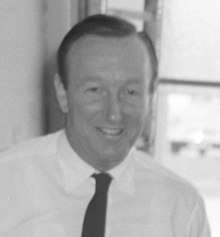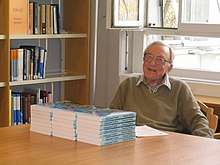Francis Farley
Francis James Macdonald Farley FRS[1] (13 October 1920 - 16 July 2018) was a British scientist. He was a Fellow of the Institute of Physics and an honorary fellow of Trinity College Dublin.[2] He was educated at Clifton College and at Clare College, Cambridge.[3] Farley obtained his PhD from Cambridge in 1950.[4]
.

During World War II he designed and made the first X-band microwave radar with 100 ns pulse and a one degree beam which directed the 15" guns at Dover.[5] It showed shells splashing around the target. He invented clutter reference Doppler radar which could see vehicles on land and was used in Italy.[6] As a senior lecturer in Auckland University he was a NZ delegate to the 1955 UN conference in Geneva on "Peaceful Uses of Atomic Energy".[7] During a year at Harwell in 1955 he measured the neutron yield from plutonium fission as a function of the incident neutron epithermal energy. From 1957 at CERN he measured the anomalous magnetic moment of the muon in three successive experiments, inventing the muon storage ring.[8][9] Accurate tests of special relativity at CERN. He participated in the follow up measurement at Brookhaven National Laboratory[10]
He started working on wave energy in 1976 and filed 14 patents in this area.[11] He was the co-inventor of the Anaconda wave energy device.[12]
He won the 1980 Hughes Medal of the Royal Society "for his ultra-precise measurements of the muon magnetic moment, a severe test of quantum electrodynamics and of the nature of the muon".[13]
1967–82 he was the academic head of the Royal Military College of Science, Shrivenham. He has been visiting professor at Yale, University of Reading, University of New South Wales and at Southampton.
Moving to France in 1986 he helped the cancer hospital Centre Antoine Lacassagne in Nice to install a 65 MeV cyclotron for proton therapy.[14] He designed the beam transport which brings the beam to the patient. Operating unmodified for 23 years the system has treated over 3000 patients for ocular melanoma with a cure rate of 95% .
Publications
His publications include the Methuen monograph "Elements of Pulse Circuits" (1955)[15] translated into French and Spanish and papers on particle physics, relativity, wave energy and cosmology.

In 2012 he wrote a romantic novel, Catalysed Fusion, which illustrates life around the accelerators at CERN and in Geneva[16]
Farley signed more than 50 peer reviewed articles. His nuclear and particle physics related publications are indexed in INSPIRE-HEP[17]
The European Patent Office has registered 17 patents with Francis Farley as the inventor.[11]
References
- "Past Fellows". Royal Society. Retrieved 26 April 2019.
- https://royalsociety.org/people/francis-farley-11421/
- Farley, F.J.M.; Vij, J.K.; Kocot, A.; Murthy, U.M.S.; Burgess, M. (1991). "Mechanical load cell based on cavity-controlled microwave oscillators". IEEE Transactions on Microwave Theory and Techniques. 39 (9): 1611–1616. doi:10.1109/22.83837. ISSN 0018-9480.
- Farley, Francis James Macdonald (1950). Some experiments with an expansion chamber (PhD). University of Cambridge.
- CA No.1 Mk3 Transmitter & receiver based on NT271, with displays from CA No 1 Mk1.
- FA No.1 Mk1 - Control of artillery fire against ground targets
- "International Conference on the Peaceful Uses of Atomic Energy". Proceedings. UN. 1956–1958.CS1 maint: date format (link)
- "Muon's (g-2): the obstinate deviation from the Standard Model". CERN Bulletin (49–50). 5 December 2011.
- "What invention is all about". CERN.
- Farley, F (2004). "The 47 years of muon g−2". Progress in Particle and Nuclear Physics. 52 (1): 1–83. doi:10.1016/j.ppnp.2003.09.004. ISSN 0146-6410.
- "Espacenet: Inventor Francis Farley". EPO. Retrieved 13 Nov 2019.
- "Peaks and troughs of wave energy: the dreams and the reality – speaker biographies". Royal Society. Retrieved 24 October 2011.
- "Hughes archive winners 1989 – 1902". Royal Society. Retrieved 5 December 2010.
- Mandrillon P, Brassart, N, Chauvel P, Courdi A, Farley F, Fietier N, Herault J, Tang JY (1992). "Recent activities of the cyclotron laboratory in Nice" (PDF). Cyclotrons 1992. Vancouver, BC, Canada: JACoW. pp. 248–251.
- Farley, Francis (1955). Elements of pulse circuits. London: Methuen. p. 151.
- Farley, Francis (2012). Catalysed Fusion. CreateSpace Independent Publishing Platform. p. 282. ISBN 978-1481018494.
- "INSPIRE-HEP: Farley, Francis James Macdonald". INSPIRE-HEP. Retrieved 13 Nov 2019.